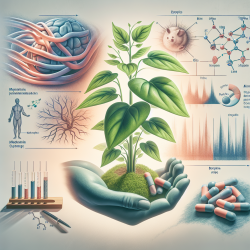Introduction
In the quest for effective treatments for Type 2 Diabetes (T2D), natural remedies have garnered attention due to their minimal side effects and diverse benefits. One such promising candidate is Chaya (Cnidoscolus chayamansa), a plant traditionally used in Central America for its medicinal properties. Recent research titled "Protective Effects of Chaya against Mitochondrial and Synaptic Toxicities in the Type 2 Diabetes Mouse Model TallyHO" sheds light on Chaya's potential in addressing mitochondrial and synaptic dysfunctions associated with T2D.
Understanding the Research
The study utilized the TallyHO mouse model, which mirrors many characteristics of human T2D, to evaluate Chaya's effects. The research involved three groups of mice: diabetic mice fed with Chaya chow, diabetic mice on a regular diet, and non-diabetic control mice. Over 11 weeks, researchers monitored body mass, fasting blood glucose, and mitochondrial and synaptic gene expressions.
Findings revealed that Chaya-fed diabetic mice exhibited reduced body mass and fasting glucose levels. Moreover, Chaya appeared to normalize mitochondrial dynamics and enhance synaptic gene expressions, suggesting its protective role against diabetes-induced mitochondrial and synaptic dysfunctions.
Implications for Practitioners
For practitioners in the field of speech-language pathology, these findings offer valuable insights into the potential of incorporating natural supplements like Chaya in therapeutic interventions. Given the link between T2D and cognitive decline, understanding and addressing mitochondrial and synaptic health can be crucial in managing diabetes-related cognitive impairments.
- Mitochondrial Health: Chaya's ability to enhance mitochondrial biogenesis and dynamics suggests its role in improving cellular energy production and reducing oxidative stress, both vital for cognitive functions.
- Synaptic Function: By increasing synaptic gene expressions, Chaya may support better neural communication, potentially mitigating cognitive decline in diabetic individuals.
Encouraging Further Research
While the study presents promising results, further research is essential to fully understand Chaya's mechanisms and its potential applications in human subjects. Practitioners are encouraged to explore Chaya's benefits in clinical settings and consider its integration into dietary recommendations for patients with T2D or at risk of cognitive decline.
Moreover, interdisciplinary collaborations can help bridge the gap between laboratory findings and practical applications, ultimately enhancing patient outcomes.
Conclusion
Chaya emerges as a natural supplement with the potential to address key challenges associated with T2D, particularly in mitochondrial and synaptic health. As we continue to seek effective and holistic approaches to managing diabetes, Chaya's role warrants further exploration and consideration in therapeutic strategies.
To read the original research paper, please follow this link: Protective Effects of Chaya against Mitochondrial and Synaptic Toxicities in the Type 2 Diabetes Mouse Model TallyHO.










